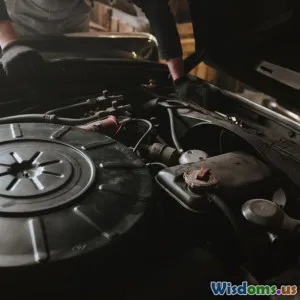
Should You Upgrade to Digital Dashboards? Pros and Cons Explained
8 min read Explore the benefits and drawbacks of upgrading to digital dashboards in vehicles for a smarter, safer driving experience. (0 Reviews)
Should You Upgrade to Digital Dashboards? Pros and Cons Explained
Introduction
Imagine a dashboard that evolves beyond mere speedometers and fuel gauges — a cockpit where vivid graphics, customizable displays, and real-time data blend seamlessly to empower drivers. This is the promise of digital dashboards. As automakers leap into the future of vehicle interfaces, many drivers are left wondering: should I upgrade to a digital dashboard? Does the high-tech allure justify the cost and potential distractions?
In this article, we'll dissect the pros and cons of digital dashboards, grounding our insights in real-world examples and data to help you decide if this automotive technology leap aligns with your driving needs.
What Are Digital Dashboards?
Digital dashboards, also known as virtual or digital instrument clusters, replace traditional analog dials with LCD, OLED, or TFT screens.
Unlike fixed mechanical gauges, they allow dynamic display configurations, integrating information such as speed, navigation, vehicle diagnostics, and multimedia controls into one interactive platform.
Notable examples include the Audi Virtual Cockpit, Mercedes-Benz's widescreen digital cockpit, and Tesla's minimalistic digital interface.
Pros of Upgrading to Digital Dashboards
1. Enhanced Customization and Information Display
Digital dashboards allow drivers to tailor the display according to preferences and requirements. For example, Mercedes-Benz drivers can switch between classic gauges, map-focused views, or performance-centric layouts.
Research by the Society of Automotive Engineers (SAE) highlights that customizable interfaces help drivers access the most relevant information efficiently, potentially improving situation awareness.
2. Improved Safety Through Integration
Digital dashboards can integrate real-time alerts such as collision warnings, lane departure notifications, and blind-spot monitoring directly into the driver’s line of sight.
For instance, Volvo’s digital cluster seamlessly incorporates such safety systems, reducing the time drivers spend looking away from the road.
3. Support for Advanced Connectivity and Infotainment
With digital dashboards, platforms like Apple CarPlay, Android Auto, and built-in GPS navigation can be displayed natively, cutting down on distractions caused by separate devices.
Tesla's Model S, for example, utilizes a comprehensive touchscreen that doubles as its dashboard, enhancing connectivity and control.
4. Future-Proofing Your Vehicle
As vehicles move towards autonomy and increased connectivity, digital dashboards provide a flexible platform to accommodate updates and additional features via software, unlike static analog instruments.
Tesla’s over-the-air updates continually refine dashboard functionality, illustrating this advantage.
Cons of Upgrading to Digital Dashboards
1. Higher Cost and Installation Complexity
Transitioning to a digital dashboard often involves costly upgrades or purchasing a new vehicle model altogether. Retrofitting can be expensive and technically challenging.
Aftermarket digital clusters can cost upwards of $1,000, excluding professional installation fees.
2. Potential for Driver Distraction
While digital dashboards offer rich information, an abundance of data may clutter the display, potentially distracting the driver.
A 2020 study by the AAA Foundation found that complex dashboard interfaces increased distraction time by up to 35%, posing safety concerns.
3. Reliability and Longevity
Analog gauges are valued for their simplicity and durability. Digital displays rely on electronic components that can fail or malfunction, especially in extreme temperatures or after long-term use.
Repairs and replacements can be expensive, and not as straightforward as swapping a failed needle or dial.
4. Learning Curve and Usability Issues
Drivers accustomed to traditional gauges may find the transition challenging. Some may feel overwhelmed or frustrated when searching for information on a digital screen compared to quick glances at analog needles.
Consumer reviews for early digital dashboards, like those introduced on the BMW i3, highlighted usability complaints.
Real-World Insights
-
Audi Virtual Cockpit: Praised for its sharp display and user-friendly interface, Audi’s digital cluster has been commended for enhancing driving enjoyment while maintaining clarity.
-
Tesla Model 3: Incorporating a minimalist digital dashboard focuses driver attention largely to a central touchscreen, polarized opinions exist: some drivers appreciate the modern aesthetic, while others express concerns about visual distraction.
-
Aftermarket Upgrades: Enthusiasts upgrading classic cars with digital clusters face both excitement over new capabilities and challenges in system integration, displaying the complexity of retrofits.
Should You Upgrade? Questions to Consider
- Is your vehicle compatible or designed for digital dashboards?
- What is your budget for upgrades or new car purchases?
- Are you comfortable adapting to new interfaces?
- Do you prioritize enhanced safety features and connectivity?
- What are your driving habits — do you prefer simplicity or technology-rich environments?
Conclusion
Digital dashboards represent a significant evolution in vehicle interface technology, offering customization, improved safety integration, and future-proof connectivity. Yet, these benefits come with trade-offs: cost, potential distraction, reliability concerns, and a learning curve.
For tech enthusiasts and those invested in the latest vehicle safety innovations, upgrading to a digital dashboard can enhance the driving experience markedly. Conversely, drivers who prefer simplicity or budget-conscious choices might find traditional analog instruments more practical.
Ultimately, the decision hinges on balancing your driving priorities with what technology can realistically provide today. As digital dashboards continue to evolve, their role in enriching and securing the driver’s interface will only grow more compelling.
Think of your dashboard not just as a tool but as an extension of your driving environment. When chosen wisely, digital dashboards can transform how you engage with your vehicle on every journey.
References:
- Society of Automotive Engineers (SAE), Human Factors Studies on Instrument Clusters
- AAA Foundation for Traffic Safety, Driver Distraction Research 2020
- Consumer Reviews: Audi Virtual Cockpit, Tesla Model 3 LCD Interface
- Aftermarket Digital Gauge Installation Guides
Rate the Post
User Reviews
Popular Posts





















